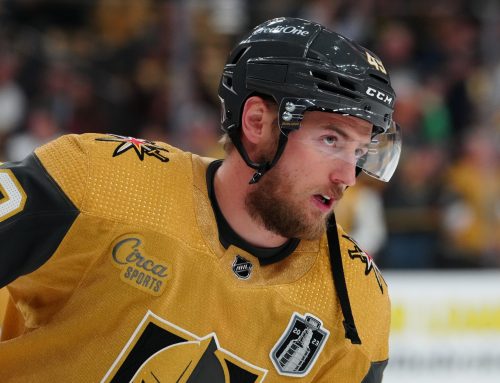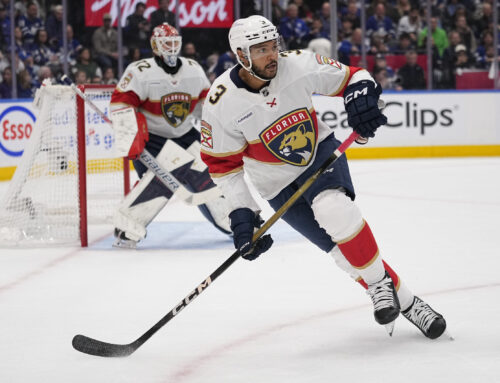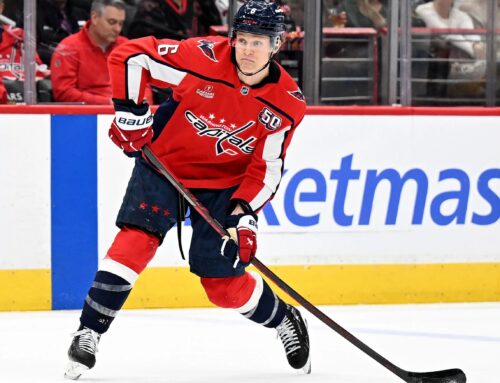Welcome to deadline season. There have been a few dominos to fall leading up to the deadline, but nothing compared to the early start we saw last year. We won't be hitting directly on a specific trade in this article, but in honor of the trade deadline, and to set our expectations accordingly when players do get moved, I wanted to take a look back and see how getting traded at the deadline impacted a player's value in the past.
More specifically we are going to look back at the 2022-23 NHL trade deadline and try to extract some general takeaways from player performance. To make it work, I have pulled two Big Board reports, one from prior to the deadline, and one post-deadline for the 2022-23 season. I exported that data and created a custom table with a few of the most interesting categories to me and then filtered by players who changed teams. As stated above, the deadline action got started early in 2022-23 with Bo Horvat moving on January 29 (the deadline itself was March 3). For the purposes of the table below, the "pre" date is actually a date in the middle of February. This means we get a few games from guys like Horvat and Ryan O'Reilly where they had already moved teams in the pre sample, but generally the paces will hold.
In the table below, the first data section contains some basic player information and then the player's 82-game pace. Since we are dealing with different sample sizes, I wanted to compare pace numbers. Next, we have percent of the team's total power-play, and total time on ice. These are included to get a general sense of a player's deployment, though certainly doesn't account for things like linemates, or shorthanded time. The gray section contains the same categories, but post deadline, and the final section is the change between these two points.
First up we are going to look at the impact changing teams had on players who were conceivably top six forwards in their original location. For this metric I simply filtered for players who were getting over 16 minutes of icetime. These are likely the most fantasy relevant players, though as we will see in a minute, we can probably further split these into top line and second line players.
| Name | Pos | Pre GP | Pre 82GP Pace | Pre %PP | Pre TOI | Post GP | Post 82GP Pace | Post %PP | Post TOI | Δ 82GP Pace | Δ 82GP %PP | Δ TOI |
| BO HORVAT | C | 54 | 88 | 70.7 | 20:51 | 18 | 36 | 66.9 | 19:47 | -52 | -3.8 | -1:04 |
| TIMO MEIER | L | 55 | 78 | 66.5 | 20:00 | 21 | 55 | 67.6 | 17:47 | -23 | 1.1 | -2:13 |
| MAX DOMI | C | 53 | 56 | 67.3 | 18:17 | 20 | 29 | 37.4 | 16:11 | -27 | -29.9 | -2:06 |
| PATRICK KANE | R | 50 | 57 | 73.4 | 19:56 | 18 | 55 | 61.2 | 17:22 | -2 | -12.2 | -2:34 |
| VLADIMIR TARASENKO | R | 41 | 62 | 56.7 | 17:20 | 20 | 53 | 40.5 | 15:41 | -9 | -16.2 | -1:39 |
| MIKAEL GRANLUND | C | 51 | 47 | 58.4 | 18:46 | 20 | 21 | 27.6 | 15:33 | -26 | -30.8 | -3:13 |
| MARCUS JOHANSSON | L | 56 | 41 | 55.4 | 16:05 | 19 | 78 | 53.3 | 17:47 | 37 | -2.1 | 1:42 |
| IVAN BARBASHEV | L | 53 | 42 | 38.5 | 16:16 | 20 | 53 | 48 | 17:32 | 11 | 9.5 | 1:16 |
| ANTHONY BEAUVILLIER | L | 55 | 36 | 34.1 | 16:09 | 21 | 35 | 38.6 | 15:44 | -1 | 4.5 | -0:25 |
| NICK BJUGSTAD | C | 55 | 34 | 9.9 | 16:53 | 19 | 26 | 9.5 | 13:45 | -8 | -0.4 | -3:08 |
| TYLER BERTUZZI | L | 22 | 30 | 50.7 | 16:14 | 21 | 62 | 47.1 | 16:30 | 32 | -3.6 | 0:16 |
In 2021-22 we saw about seven of these types of players moved, and in 2022-23 we jumped up to 11. Taking a look at the list we can set a bar of 17 minutes for top line players which would leave us with Horvat, Timo Meier, Max Domi, Patrick Kane, Mikael Granlund, and Vladimir Tarasenko. Less than 17 minutes gives us Marcus Johansson, Ivan Barbashev, Anthony Beauvillier, Nick Bjugstad, and Tyler Bertuzzi. Based on prior year's examples we would expect that essentially all of the top line players would be losing out of time and point pace and a good chunk of the second line players would be also.
In 2022-23, this is essentially what happens. Every single person who was getting over 17 minutes a night on average lost both total time on ice, and dropped in point pace. Most also lost power-play time and at best managed to keep the same. Additionally, no one managed to maintain more than a 70-point pace after being traded even if they had been doing so prior to the deadline. This is slightly different than in 2021-22 where Claude Giroux and Andrew Copp managed to increase their paces above point per game. Our second line skaters were a bit more of a mixed bag though. Three increased time on ice and point paces (some by a significant margin), while two ended up losing out overall.
The takeaway from this data set is definitely a warning for guys who were top line players before moving teams (looking at you Elias Lindholm). This makes a lot of logical sense. Typically, these are players who were being relied upon by non-playoff teams moving to teams with a more crowded forward core. They are usually treated as supplementary rather than integral to the new team's success.
The caveat here is with players who are second line/middle six. Sometimes they seem to be able to move to a new team that has a spot for them. Tyler Bertuzzi jumped into top line/power-play deployment because Boston had injuries/was resting a lot of their core. Ivan Barbashev slotted immediately in next to Jack Eichel, and Marcus Johansson got some top line deployment as well, also at times because of injuries. Clearly these are positive situations to be in after a trade, though not necessarily predictable. Barbashev is the one person on this list who got some hype because he was traded, saw an immediate bump and held it. Bertuzzi (who actually started on the third line) and Johansen were helped by and large because of injuries that happened later.
If we next look to our bottom six, we have about 15 players who were moved at the deadline. I am not going to include the entire list here, but honestly the news isn't great. There were only three players who performed at above a 50-point pace after the deadline. There were two (of ten) in 2021-22.
Only five players of the 15 in 2022-23 actually increased ice time (meaning that most were depth pieces brought in to be depth pieces). Further, two of them only show an increase in ice time because they only played one or two games prior to the deadline, so we really only have three players who saw an actual increase in their deployment. The thing that is very consistent here from prior years is that essentially the only benefit was for depth pieces who moved to a non-playoff team. The best performers after the deadline in 2022-23 were Jakub Vrana and Sammy Blais. Both were moved to a decimated Blues roster and got essentially top six deployment for big chunks of time.
To put a bow on the forward conversation here: Generally speaking, being moved at the deadline does not translate to increased success. The exceptions appear to be a depth player being moved to a non-playoff team and seeing a big increase in deployment (Vrana), and a role player moving to fill a specific opening next to productive players (Barbashev, and to some extent Bertuzzi and Johansson).
The challenge is knowing which of the players who moved are going to fit those categories. Beauvillier certainly was given great deployment to start (just like Barbashev) but ultimately couldn't do anything with it or hold it the rest of the season. As mentioned, Bertuzzi didn't start with it, but eventually stepped up in a big way when Boston had holes in their top six. The takeaway seems to be grabbing middle six players (since the top players are already rostered) is a low percentage play. It's worth a gamble if you aren't giving up too much, it looks like the deployment is going to be good, and you are in need of a bit of a hail mary, but probably isn't ultimately going to pan out for the vast majority of mid-tier players moved.
Next week we will take a look at defensemen.
That is all for this week. Do your part to support organizations working to make hockey for everyone.





 S.J
S.J EDM
EDM ANA
ANA PIT
PIT BUF
BUF
 CBJ
CBJ MIN
MIN DET
DET UTA
UTA MTL
MTL
